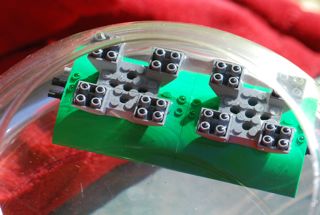Want a first hand look at young scientists exploring a recently discovered phenomenon? Plastic, Ahoy!: Investigating the Great Pacific Garbage Patch by Patricia Newman, with photographs by Annie Crawley introduces the middle grade level reader to three graduate students who spend nearly three weeks aboard a research vessel in the Pacific Ocean taking samples from what is called the “Great Pacific Garbage Patch.”
In August of 2009, Miriam Goldstein, Chelsea Rochman, and Darcy Taniguchi departed on a ship as part of the Scripps Environmental Accumulation of Plastic Expedition or SEAPLEX (see the blog). The book chronicles their observations and experiences.
You can get a feel for the book in this trailer:
Surprisingly, the students found that much of the plastic in the Garbage Patch is small broken pieces, basically “the size of confetti.” The small size is going to make removing the plastic from the water very difficult because any net that is the right size to capture the bits of plastic will also capture all sorts of marine life. The bottom line is that these are not all full-sized water bottles floating around.
The team members also discovered that 9% of 147 the fish they sampled during the trip had plastic bits in their stomachs. Given that there is some evidence plastic bits tend to accumulate toxins from the water, this could have long term negative consequences to food chains. Obviously more studies need to be done.
Not all the news was necessarily negative, however. One study found that sea-going relatives of water striders called “sea striders” are actually doing better in the Garbage Patch because more debris means more places they can lay their eggs (Plastic Trash Altering Ocean Habitats, Scripps Study Shows).
Plastic, Ahoy! can be a jumping off point for many potential science experiments and explorations of your own. Here are just a few ideas:
1. The lifespans of plastic objects
How long will your trash bag live? is an idea for a science fair project that compares the longevity of plastic, paper, and biodegradable plastic bags buried in the ground. This is a long duration experiment (months).
In this article, a Teen Decomposes Plastic Bag in Three Months
2. Preventing plastic from reaching the ocean
Science Buddies has a science fair project idea for looking at the design of storm drains with the idea of keeping trash from getting into the water
3. Floating ocean trash experiments from previous post at Growing with Science
4. The National Ocean and Atmospheric Administration’s Marine Debris Program has educational materials such as:
- activities (free downloadable printables)
- curriculum (Turning the Tide on Trash: A Learning Guide on Marine Debris)
- art contest (see flyer in resources for 2014 details)
- fact sheets
Plastic, Ahoy!: Investigating the Great Pacific Garbage Patch by Patricia Newman, with photographs by Annie Crawley is an exciting introduction to science, told through the stories of actual young scientists. You will want to share it with children interested in marine biology, chemistry and conservation. It would make perfect reading for Earth Day (April 22, 2014) or World Ocean Day (June 8, 2014) or a unit on the environment, particularly the marine environment.
Recommended Ages:Â 8-12
Publisher: Millbrook Pr Trade (January 1, 2014)
ISBN-10: 1467712833
ISBN-13: 978-1467712835
Disclosures: This book was provided for review via Blue Slip Media. Also, I am an affiliate for Amazon, and if you click through the linked titles or ads and make a purchase, I will receive a small commission at no extra charge to you. Proceeds will be used to maintain this self-hosted blog.
Come visit the STEM Friday blog each week to find more great Science, Technology, Engineering and Math books.





